
FTAI Aviation (FTAI)
FTAI Aviation is a special business. Its high growth, robust unit economics, and optimistic prospects make it a spectacular asset.― StockStory Analyst Team
1. News
2. Summary
Why We Like FTAI Aviation
With a focus on the CFM56 engine that powers Boeing and Airbus’s planes, FTAI Aviation (NASDAQ:FTAI) sells, leases, maintains, and repairs aircraft engines.
- Market share has increased this cycle as its 39% annual revenue growth over the last five years was exceptional
- Incremental sales significantly boosted profitability as its annual earnings per share growth of 82.4% over the last two years outstripped its revenue performance
- Notable projected revenue growth of 32.3% for the next 12 months hints at market share gains


FTAI Aviation is at the top of our list. The price looks fair relative to its quality, and we think now is the time to invest.
Why Is Now The Time To Buy FTAI Aviation?
High Quality
Investable
Underperform
Why Is Now The Time To Buy FTAI Aviation?
FTAI Aviation’s stock price of $173.19 implies a valuation ratio of 27.8x forward P/E. While this multiple is higher than most industrials companies, we think the valuation is fair given its quality characteristics.
Entry price may seem important in the moment, but our work shows that time and again, long-term market outperformance is determined by business quality rather than getting an absolute bargain on a stock.
3. FTAI Aviation (FTAI) Research Report: Q3 CY2025 Update
Aircraft leasing company FTAI Aviation (NASDAQ:FTAI) met Wall Street’s revenue expectations in Q3 CY2025, with sales up 43.2% year on year to $667.1 million. Its GAAP profit of $1.10 per share was 11.4% below analysts’ consensus estimates.
FTAI Aviation (FTAI) Q3 CY2025 Highlights:
- Revenue: $667.1 million vs analyst estimates of $665.5 million (43.2% year-on-year growth, in line)
- EPS (GAAP): $1.10 vs analyst expectations of $1.24 (11.4% miss)
- Adjusted EBITDA: $297.4 million vs analyst estimates of $280.8 million (44.6% margin, 5.9% beat)
- EBITDA guidance for the full year is $1.46 billion at the midpoint, above analyst estimates of $1.20 billion
- Operating Margin: 30.1%, down from 32% in the same quarter last year
- Market Capitalization: $18.66 billion
Company Overview
With a focus on the CFM56 engine that powers Boeing and Airbus’s planes, FTAI Aviation (NASDAQ:FTAI) sells, leases, maintains, and repairs aircraft engines.
As mentioned, part of its business generates revenue through the leasing and maintenance of aviation assets. The CFM56 engine, which is the most common jet engine in commercial aircrafts today, comprises a large part of FTAI’s asset portfolio. This part of the business enjoys steady, recurring revenues tied to long-term leases since the useful life of these aviation assets can be multiple decades.
The other part of FTAI’s business develops and manufactures aftermarket components for aircraft engines such as the CFM56 model we mentioned earlier. FTAI parlays these aftermarket components to win maintenance business as well. In the area of maintenance, the company takes a modular approach to repairing and overhauling engines that saves both time and expense for customers such as airlines and lessors.
FTAI leases its aviation assets to airlines and other leasing companies. These customers tend to have a mix of owned and leased assets for reasons revolving around financial flexibility, capital availability, and shorter-term swings in travel demand. For these customers, “time on wing” is important, which is why FTAI wants to not only lease dependable assets but also wants to maintain and repair them in the most efficient manner possible.
4. Vehicle Parts Distributors
Supply chain and inventory management are themes that grew in focus after COVID wreaked havoc on the global movement of raw materials and components. Transportation parts distributors that boast reliable selection in sometimes specialized areas combined and quickly deliver products to customers can benefit from this theme. Additionally, distributors who earn meaningful revenue streams from aftermarket products can enjoy more steady top-line trends and higher margins. But like the broader industrials sector, transportation parts distributors are also at the whim of economic cycles that impact capital spending, transportation volumes, and demand for discretionary parts and components.
Competitors in the aircraft leasing industry include AerCap (NYSE:AER), Air Lease Corporation (NYSE:AL), and GATX Corporation (NYSE:GATX).
5. Revenue Growth
A company’s long-term sales performance can indicate its overall quality. Any business can put up a good quarter or two, but many enduring ones grow for years. Thankfully, FTAI Aviation’s 39% annualized revenue growth over the last five years was incredible. Its growth surpassed the average industrials company and shows its offerings resonate with customers, a great starting point for our analysis.
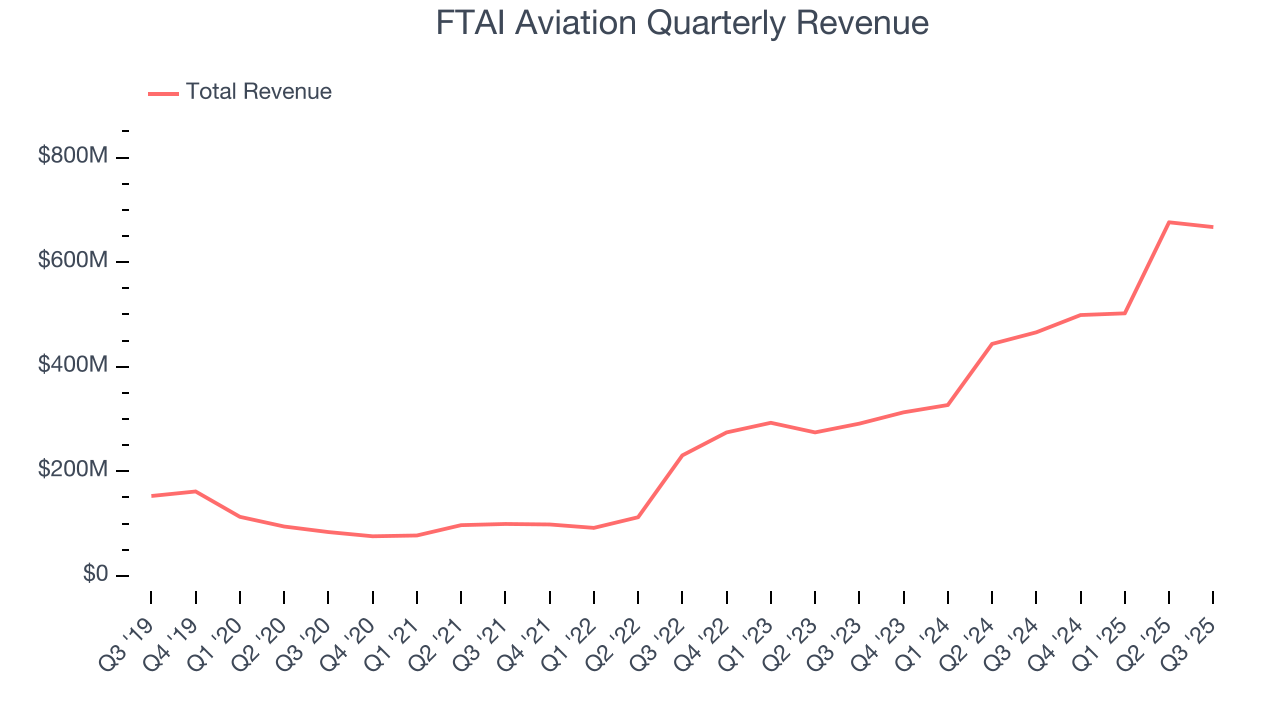
We at StockStory place the most emphasis on long-term growth, but within industrials, a half-decade historical view may miss cycles, industry trends, or a company capitalizing on catalysts such as a new contract win or a successful product line. FTAI Aviation’s annualized revenue growth of 43.9% over the last two years is above its five-year trend, suggesting its demand was strong and recently accelerated. 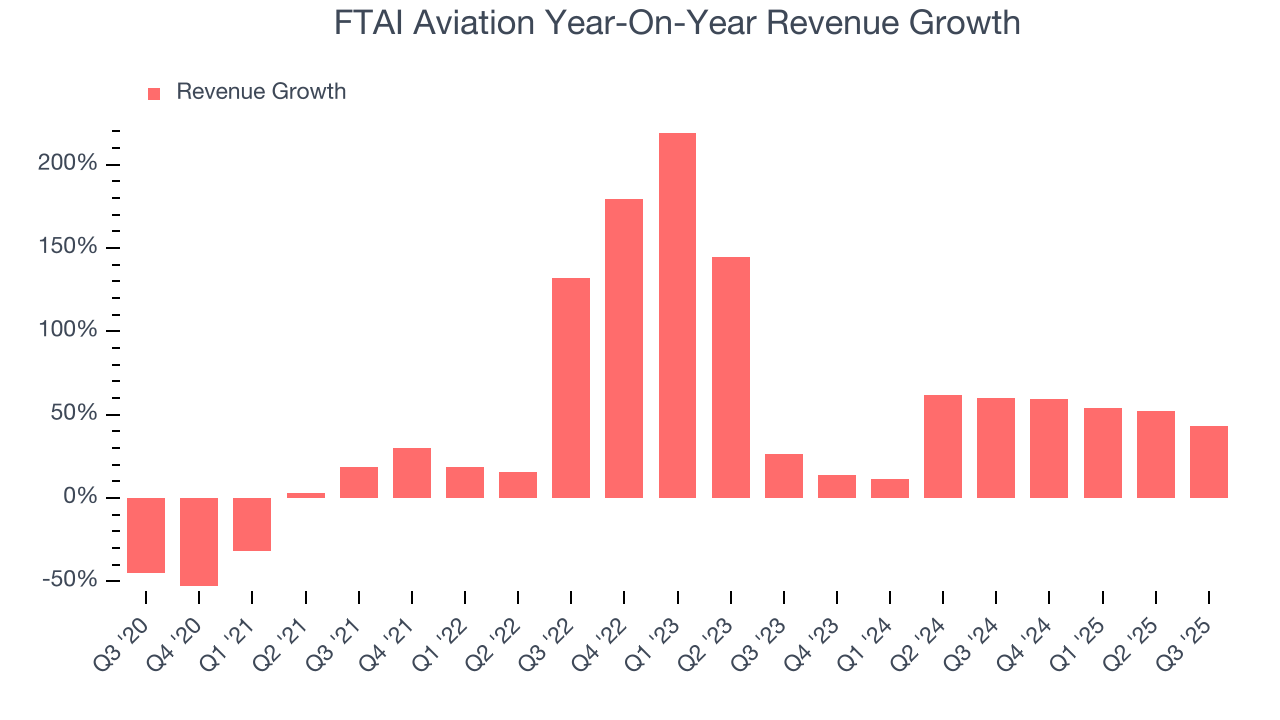
This quarter, FTAI Aviation’s year-on-year revenue growth of 43.2% was magnificent, and its $667.1 million of revenue was in line with Wall Street’s estimates.
Looking ahead, sell-side analysts expect revenue to grow 30.1% over the next 12 months, a deceleration versus the last two years. Despite the slowdown, this projection is healthy and indicates the market sees success for its products and services.
6. Gross Margin & Pricing Power
At StockStory, we prefer high gross margin businesses because they indicate the company has pricing power or differentiated products, giving it a chance to generate higher operating profits.
FTAI Aviation has best-in-class unit economics for an industrials company, enabling it to invest in areas such as research and development. Its margin also signals it sells differentiated products, not commodities. As you can see below, it averaged an elite 47.2% gross margin over the last five years. That means FTAI Aviation only paid its suppliers $52.80 for every $100 in revenue. 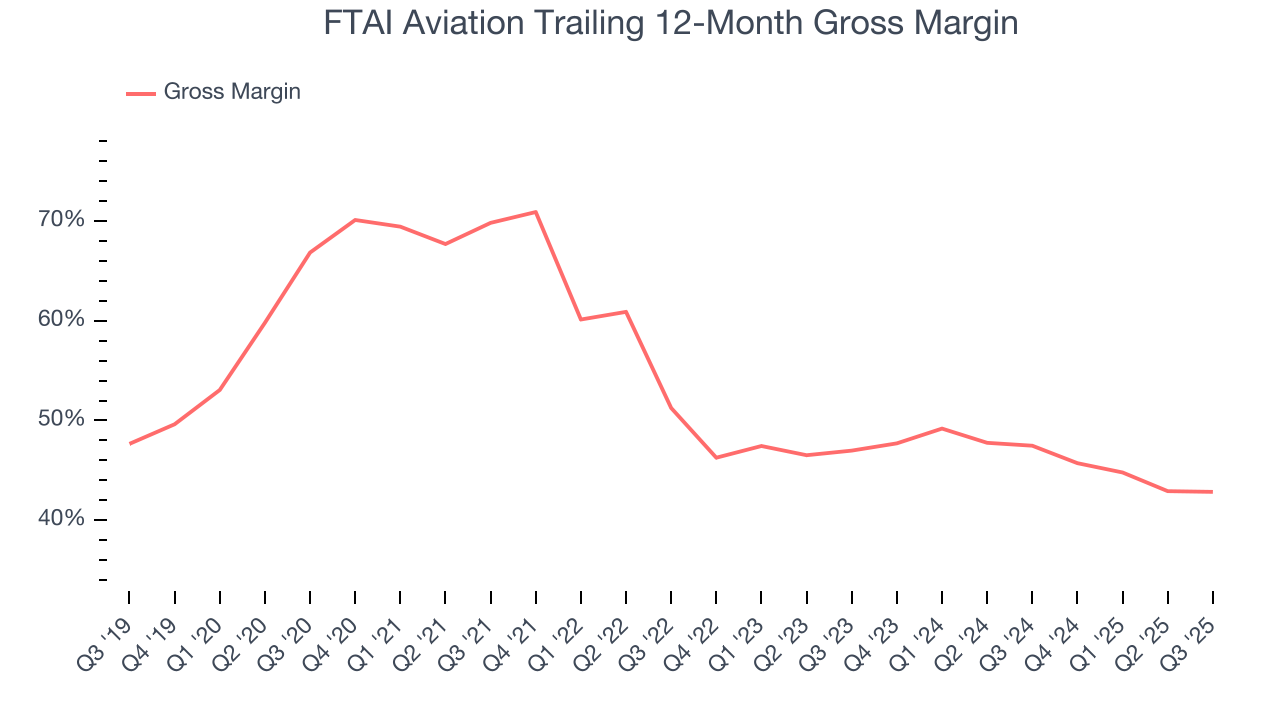
FTAI Aviation’s gross profit margin came in at 45.6% this quarter, down 1.5 percentage points year on year. FTAI Aviation’s full-year margin has also been trending down over the past 12 months, decreasing by 4.6 percentage points. If this move continues, it could suggest a more competitive environment with some pressure to lower prices and higher input costs (such as raw materials and manufacturing expenses).
7. Operating Margin
Operating margin is one of the best measures of profitability because it tells us how much money a company takes home after procuring and manufacturing its products, marketing and selling those products, and most importantly, keeping them relevant through research and development.
FTAI Aviation has been a well-oiled machine over the last five years. It demonstrated elite profitability for an industrials business, boasting an average operating margin of 19.4%. This result isn’t surprising as its high gross margin gives it a favorable starting point.
Looking at the trend in its profitability, FTAI Aviation’s operating margin rose by 27 percentage points over the last five years, as its sales growth gave it immense operating leverage.
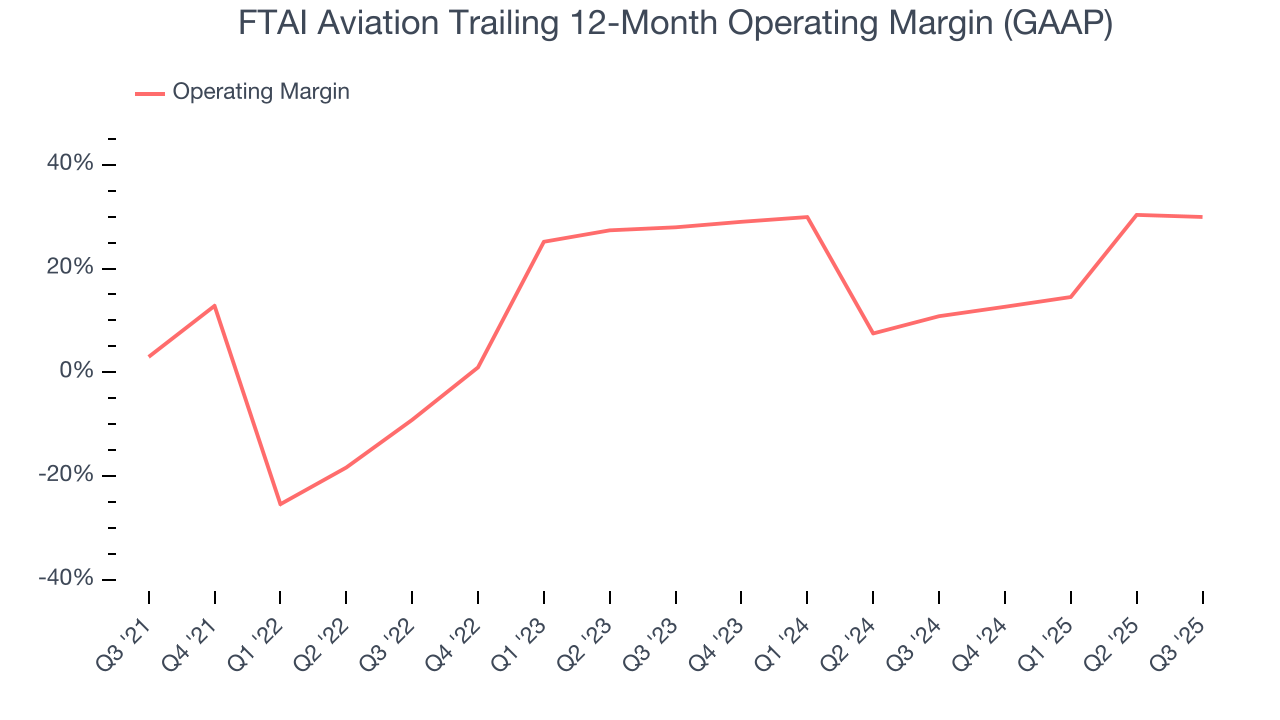
In Q3, FTAI Aviation generated an operating margin profit margin of 30.1%, down 1.9 percentage points year on year. Since FTAI Aviation’s operating margin decreased more than its gross margin, we can assume it was less efficient because expenses such as marketing, R&D, and administrative overhead increased.
8. Earnings Per Share
We track the long-term change in earnings per share (EPS) for the same reason as long-term revenue growth. Compared to revenue, however, EPS highlights whether a company’s growth is profitable.
FTAI Aviation’s EPS grew at an astounding 22.1% compounded annual growth rate over the last five years. Despite its operating margin improvement during that time, this performance was lower than its 39% annualized revenue growth, telling us that non-fundamental factors such as interest and taxes affected its ultimate earnings.
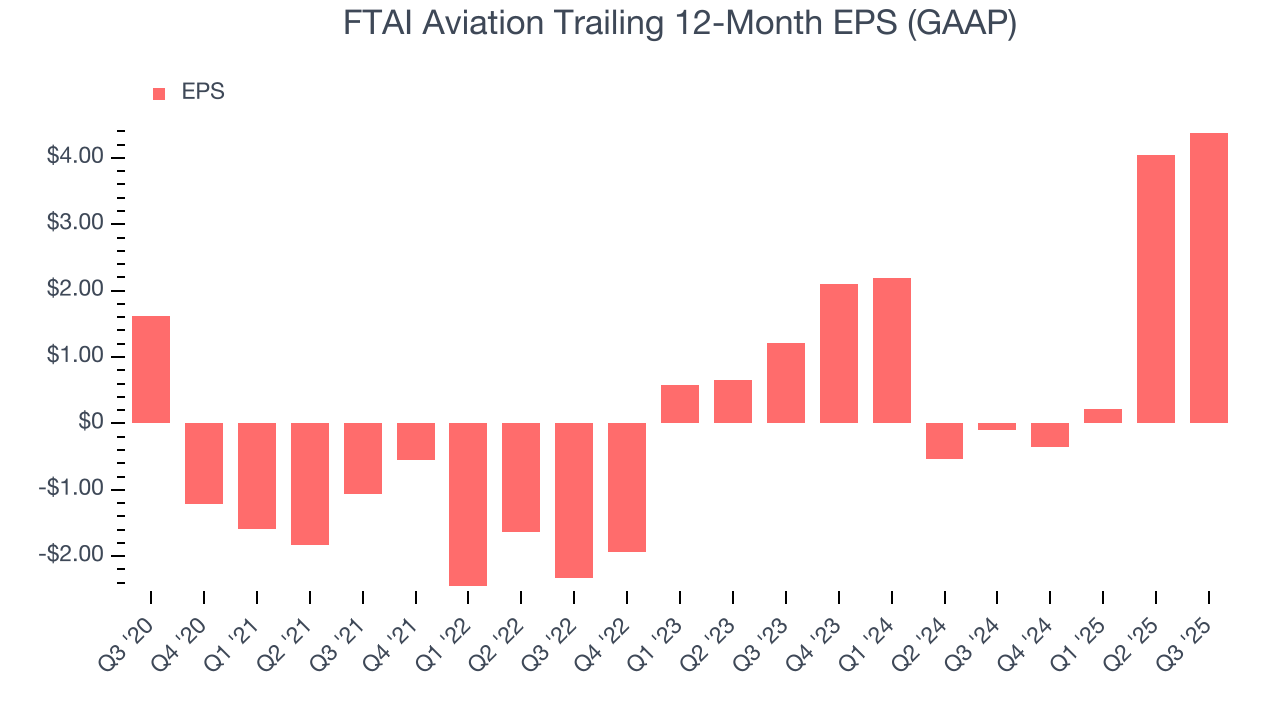
Diving into FTAI Aviation’s quality of earnings can give us a better understanding of its performance. A five-year view shows FTAI Aviation has diluted its shareholders, growing its share count by 20.9%. This dilution overshadowed its increased operational efficiency and has led to lower per share earnings. Taxes and interest expenses can also affect EPS but don’t tell us as much about a company’s fundamentals. 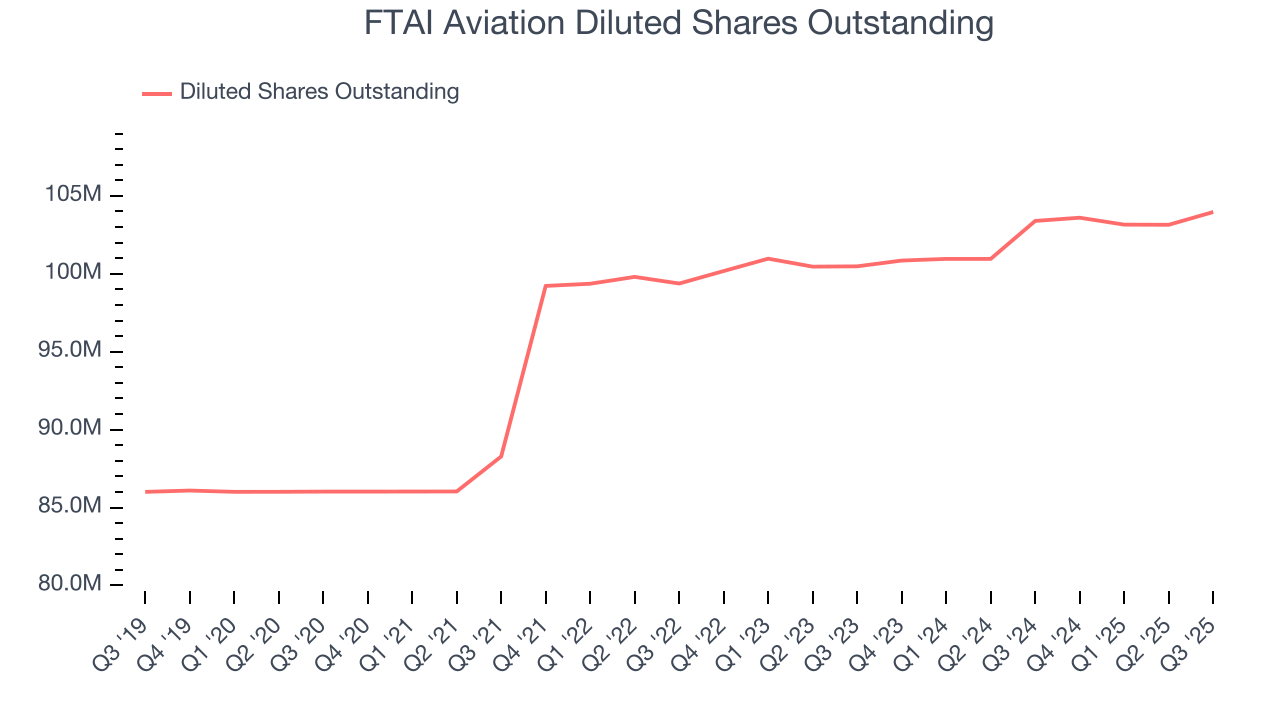
Like with revenue, we analyze EPS over a more recent period because it can provide insight into an emerging theme or development for the business.
For FTAI Aviation, its two-year annual EPS growth of 90.3% was higher than its five-year trend. We love it when earnings growth accelerates, especially when it accelerates off an already high base.
In Q3, FTAI Aviation reported EPS of $1.10, up from $0.76 in the same quarter last year. Despite growing year on year, this print missed analysts’ estimates, but we care more about long-term EPS growth than short-term movements. Over the next 12 months, Wall Street expects FTAI Aviation’s full-year EPS of $4.38 to grow 57%.
9. Cash Is King
Although earnings are undoubtedly valuable for assessing company performance, we believe cash is king because you can’t use accounting profits to pay the bills.
FTAI Aviation’s demanding reinvestments have drained its resources over the last five years, putting it in a pinch and limiting its ability to return capital to investors. Its free cash flow margin averaged negative 97.4%, meaning it lit $97.43 of cash on fire for every $100 in revenue. This is a stark contrast from its operating margin, and its investments in working capital/capital expenditures are the primary culprit.
Taking a step back, an encouraging sign is that FTAI Aviation’s margin expanded during that time. In light of its glaring cash burn, however, this improvement is a bucket of hot water in a cold ocean.

10. Return on Invested Capital (ROIC)
EPS and free cash flow tell us whether a company was profitable while growing its revenue. But was it capital-efficient? A company’s ROIC explains this by showing how much operating profit it makes compared to the money it has raised (debt and equity).
Although FTAI Aviation has shown solid business quality lately, it historically did a mediocre job investing in profitable growth initiatives. Its five-year average ROIC was 7.3%, somewhat low compared to the best industrials companies that consistently pump out 20%+.
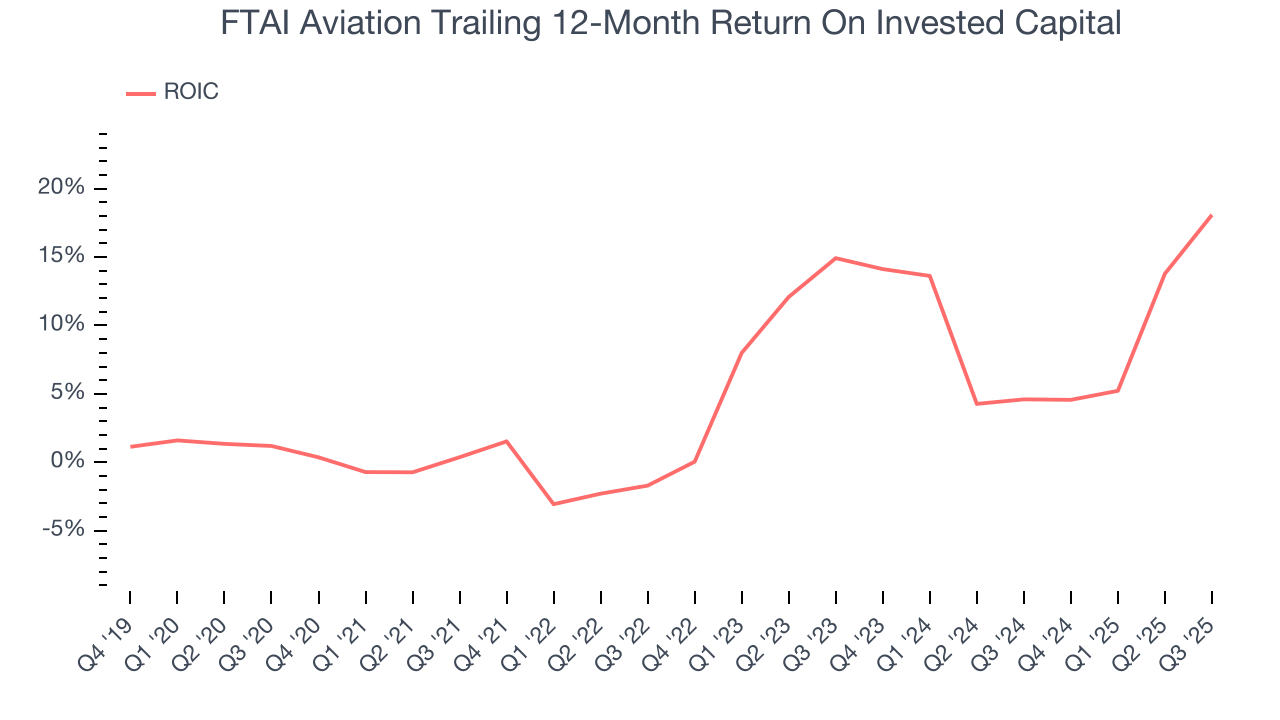
We like to invest in businesses with high returns, but the trend in a company’s ROIC is what often surprises the market and moves the stock price. Fortunately, FTAI Aviation’s ROIC has increased significantly over the last few years. its rising ROIC is a good sign and could suggest its competitive advantage or profitable growth opportunities are expanding.
11. Balance Sheet Assessment
FTAI Aviation reported $509.9 million of cash and $3.45 billion of debt on its balance sheet in the most recent quarter. As investors in high-quality companies, we primarily focus on two things: 1) that a company’s debt level isn’t too high and 2) that its interest payments are not excessively burdening the business.
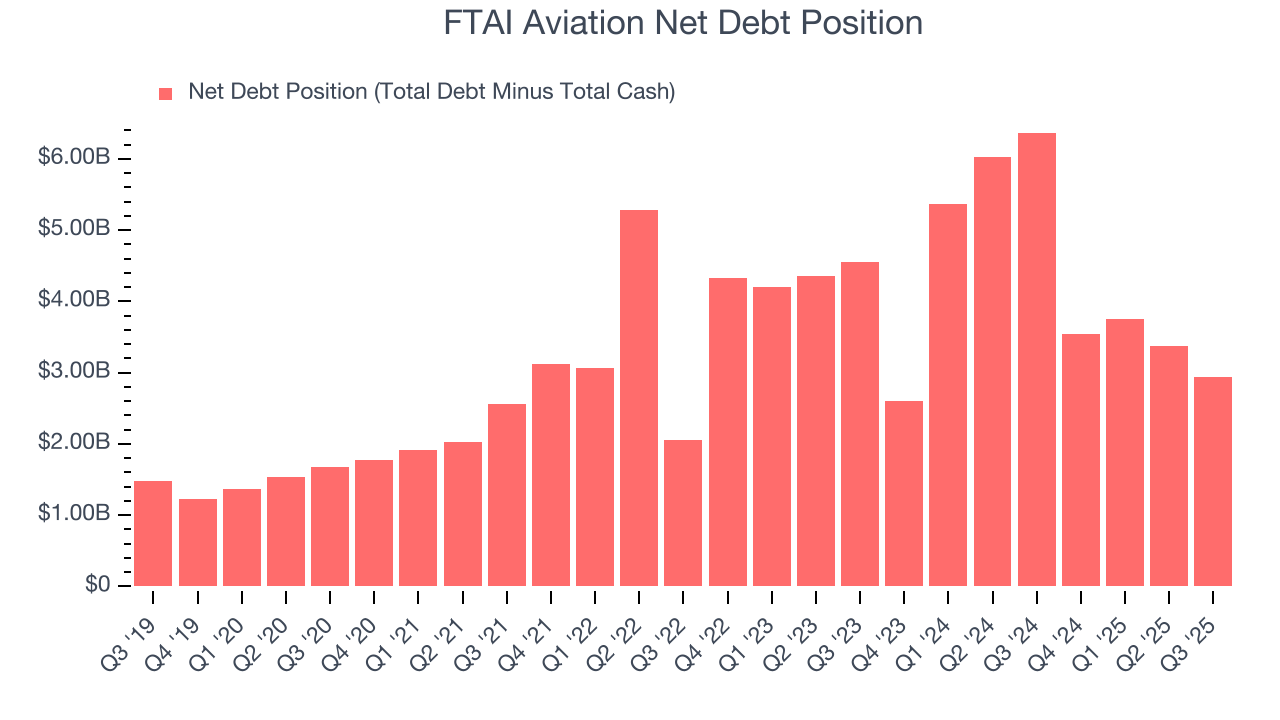
With $1.17 billion of EBITDA over the last 12 months, we view FTAI Aviation’s 2.5× net-debt-to-EBITDA ratio as safe. We also see its $126.1 million of annual interest expenses as appropriate. The company’s profits give it plenty of breathing room, allowing it to continue investing in growth initiatives.
12. Key Takeaways from FTAI Aviation’s Q3 Results
We were impressed by FTAI Aviation’s optimistic full-year EBITDA guidance, which exceeded analysts’ expectations. We were also glad its EBITDA outperformed Wall Street’s estimates. On the other hand, its revenue was just in line. Overall, this print had some key positives. Investors were likely hoping for more, and shares traded down 5% to $176.08 immediately after reporting.
13. Is Now The Time To Buy FTAI Aviation?
Updated: December 24, 2025 at 10:25 PM EST
The latest quarterly earnings matters, sure, but we actually think longer-term fundamentals and valuation matter more. Investors should consider all these pieces before deciding whether or not to invest in FTAI Aviation.
There is a lot to like about FTAI Aviation. For starters, its revenue growth was exceptional over the last five years. And while its cash burn raises the question of whether it can sustainably maintain growth, its admirable gross margins indicate the mission-critical nature of its offerings. Additionally, FTAI Aviation’s impressive operating margins show it has a highly efficient business model.
FTAI Aviation’s P/E ratio based on the next 12 months is 28x. Analyzing the industrials landscape today, FTAI Aviation’s positive attributes shine bright. We think it’s one of the best businesses in our coverage and like the stock at this price.
Wall Street analysts have a consensus one-year price target of $227.10 on the company (compared to the current share price of $173.26), implying they see 31.1% upside in buying FTAI Aviation in the short term.












